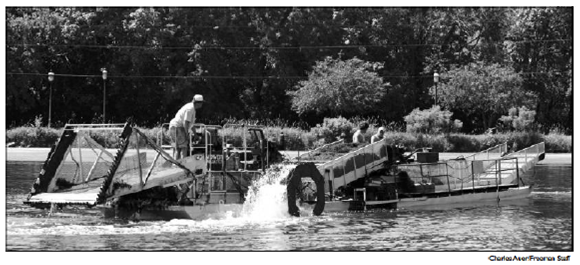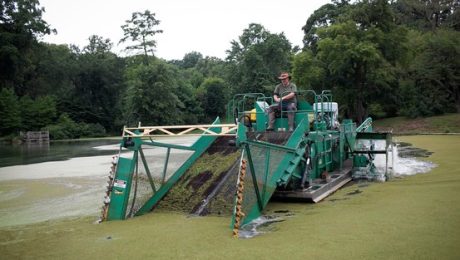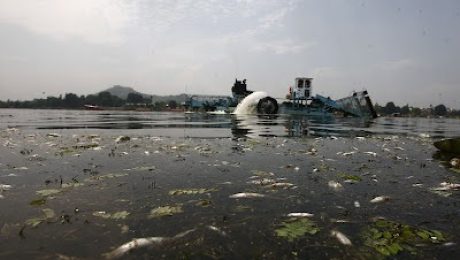Waukesha Freeman, July 6, 2011 – Workers from Midwest Aquatics unload cut weeds from a mechanical harvester in the Fox River off of Frame Park on Tuesday. Aquatic weeds are cut, then taken from the water on a conveyor, then transfered to a second boat and removed. This 1990 Aquarius Systems HM-320 Aquatic Plant Harvester
Martin Woess and his aquatic weed harvester dubbed the Lake Mess Monster has been busy clearing the waters of Prospect Park. Once a week Woess climbs aboard his weed harvester to collect the scum which consists mostly of duckweed and azolla which would quickly take over the pond if left unchecked. New York City owns two of
When Pflugerville officials saw hydrilla and pondweed overtaking parts of Lake Pflugerville they called in the Moss Monster. The fast-growing aquatic plants can overcrowd a body of water, which hinders recreational activities and disrupts the ecosystem. Park and city officials fight back against the aquatic plants with mechanical trimmers and specialized fish. For James Wills,
Black Hawk Lake in Iowa will have an aquatic vegetation harvester operating for the fourth year in a row to manage plant growth in the waters near Lake View. Lake View City Administrator, Scott Peterson, says they have developed a system to manage the weeds in a way which benefits all users of the lake.
Indian Kashmir used to be a place people compared to mythical Shangri-La–verdant and unspoiled. And Nigeen Lake, in a green valley surrounded by the Himalayas, is considered by waterways officials to be the least polluted waterway in the city of Srinagar (population 1.3 million). Nigeen is important for tourism, recreation, and the city’s image, but
The annual weed pull calling volunteers to Bare Hill Pond in Harvard, Massachusetts; to yank invading water chestnut weeds from the pond’s depths wasn’t held this year. Why? Volunteer Rick Dickson said, “because we finally don’t need it.” The plant is injurious with its four-headed needle-sharp seeds typically making it to shore and cutting the
The Cazenovia Lake Association in coordination with the town, New York Department of Environmental Conservation and other entities is continually looking for methods to control the spread of the invasive Eurasian Milfoil weed. The two methods that are currently employed are the use of a weed harvester and the use of an herbicide. The control
Before issuing a request for quotations to private contractors for the mechanical harvesting of macrophytes, or pond weeds, as part of cleanup efforts at Mill Pond in East Falmouth, the Falmouth Water Quality Management Committee will gather additional information about permitting requirements from the state as well as the permit process from the Town of
The water of Half Moon Lake in Eau Claire, Wisconsin, will hopefully be clearer once the city’s parks, recreation, and forestry division is done harvesting the aquatic vegetation. Due to the significant amount of floating weeds throughout the lake, the city and the Wisconsin Department of Natural Resources are working together to solve the problem.
Bow fishing, as opposed to an environmental fish kill, is behind the recent culling of hundreds of carp in Paddock Lake, Wisconsin. Flooding led to a rush of runoff into the lake, which, in turn, reduced oxygen levels. This can lead to a natural fish kill, and some carp perished as a result. However, village
- 1
- 2









